skip to main |
skip to sidebar
 Topographical map of Honduras
Topographical map of Honduras
There aren't a lot of good updated maps of Honduras. We had a large map which had some handy street maps of the larger cities. Someone stole it out of our car! I was able to find these maps on the internet which I thought might be of interest to you.
Most of these are from (of all places) the University of Texas Library. The site indicates that these are in the public domain so it is okay for me to use them and okay for you to copy them if you wish. You might get a better copy if you go the link below each map though.
You can see that most of Honduras is mountainous. The large flat area to the east called Gracias a Dios is primarily swamps or wetlands and is only sparsely inhabited. It includes the area variously called La Moskitia for the native Miskito indians, La Mosquitia in Spanish, or the Mosquito Coast in English that was the setting of the Harrison Ford movie by the same name.
The CIA Factbook states that Honduras contains 112,090 sq. km. (43,278 sq. mi.), about the size of Tennessee. The major roads are marked in red on the above map. You can see that there aren't many.
You will probably have to click these maps and enlarge them to be able to read them.
Amazing that only 6% of the land is considered arable. Much of the country is covered with mountains.
 Completely, horribly outdated, but it will still give you an idea of how the population is distributed across the country. I imagine that many of the small towns haven't changed a whole lot, while the larger cities have become much more populated. The CIA Factbook estimates the current population to be 7.3 million, of which 40% are under the age of 15. The median age is 19.5.
Completely, horribly outdated, but it will still give you an idea of how the population is distributed across the country. I imagine that many of the small towns haven't changed a whole lot, while the larger cities have become much more populated. The CIA Factbook estimates the current population to be 7.3 million, of which 40% are under the age of 15. The median age is 19.5.
Population estimates vary widely but just to give you an idea, the capital city of Tegucigalpa has an estimated population of about 1.5 million, the industrial capital San Pedro Sula about 1 million, and La Ceiba, the third largest city, about 250,000 including the surrounding aldeas (villages). This is very old data (1983) but ....
This is very old data (1983) but ....
There are many more maquillas (factories) now than there were in the 1980's, especially in and around San Pedro Sula, El Progresso, Puerto Cortes, and other areas.
 This is one of the only Honduran government issued map that I could locate. Honduras is divided into 18 departamentos (states). The yellow one at the top is Atlantida and that's were La Gringa lives.
This is one of the only Honduran government issued map that I could locate. Honduras is divided into 18 departamentos (states). The yellow one at the top is Atlantida and that's were La Gringa lives.
 This is "our" mountain
This is "our" mountain
Almost every evening around 6 p.m., we have been getting some rain for a short time. The cool night air is great for sleeping. Some nights it has been down in the 70°s F (25°C) when I go to bed.
Last night in particular, it seemed really cool. Out of curiosity, I glanced at the weather sticker on my blog. Wow! It was -9999 degrees. It didn't seem quite that cool to me.
I don't need to translate that to Celsius for you, do I?
 Honduran Minister of Tourism
Honduran Minister of TourismHe welcomes the expected increase of 200,000 national tourists but he would like to see more, if it weren’t for the limited hotel capacity. “1.8 million Hondurans traveling during three days is not much. We would like to see at least 50 percent of the Honduran population traveling.”
Apparently no one told him that 60% of the population lives below the poverty line and would have a tough time coming up with bus fare for their families much less money for restaurants and hotels. Not to mention the fact that some portion of the population will have to work in those restaurants and hotels and drive the buses, etc.I really think this is so typical of the elite who become politicians. It's a little like the former (I'm happy to say former) minister of education who told teachers who hadn't received their government paychecks for months that they should just take out loans to meet their obligations. They really don't have a clue.The HTW article also states that "Honduras is expecting 1.8 million Honduran and 60,000 foreign travelers during the upcoming Semana Santa (Holy week). Easter Week is an important source of income for the Honduran tourism industry, as Honduran and Central American visitors spend an average of $250 per visit, North Americans $1,000 and Europeans $1,200."The minimum wage in Honduras is around U.S. $100 per month.
 I've been keeping a secret from you. We have a new maid or housekeeper, empleada, whatever you want to call her. Here in La Ceiba, the Honduran ladies usually call them muchachas, which literally means girls. Not very politically correct, but that's what it is.She started last Wednesday but I didn't want to mention it just in case she turned out like the last one who left after two days. Here it is Tuesday and she's back again. ¡Ay caramba!She is a Garífuna from Corozal, a little town east of La Ceiba. (The Garífunas have an interesting history.) Josaly has four children, the youngest of whom is only six months and she does have a husband. Her husband is a fisherman and he also makes jewelry and souvenirs out of coconut shells. I'm going to try to get her to bring some one day so I can take some pictures.I don't know why, but I was telling her (or trying to tell, I can never be entirely sure with my Spanish) about how I don't understand why we can never keep a housekeeper. I said that I don't think I am so bad and she sort of snorted and said "no, you're not." She said it like she meant it, not like it was an obligatory answer, so I felt good about that. We agreed to discuss the cultural differences so that neither one of us has hard feelings. I also told her that in my culture, people never, ever tell a woman that she is fat − let's nip that one in the bud!Josaly also gave me the inside scoop on one of our previous maids. She said P drinks (a lot) and that's why she missed so much work. Ahah! P was the one who asked me to give her the bottle of rum she found in the cupboard for her 5-year-old's birthday party.I know it is too soon to be hopeful, but so far she has been very pleasant, seems to like the animals, and is a good worker. She's not yet convinced about not using chemicals and bleach everywhere, but hopefully we'll get there!With Frank still here and now Josaly, I'm spending a lot of time supervising and speaking Spanish. By 4:00, I think I'm more exhuasted than they are. My brain is exhausted anyway.
I've been keeping a secret from you. We have a new maid or housekeeper, empleada, whatever you want to call her. Here in La Ceiba, the Honduran ladies usually call them muchachas, which literally means girls. Not very politically correct, but that's what it is.She started last Wednesday but I didn't want to mention it just in case she turned out like the last one who left after two days. Here it is Tuesday and she's back again. ¡Ay caramba!She is a Garífuna from Corozal, a little town east of La Ceiba. (The Garífunas have an interesting history.) Josaly has four children, the youngest of whom is only six months and she does have a husband. Her husband is a fisherman and he also makes jewelry and souvenirs out of coconut shells. I'm going to try to get her to bring some one day so I can take some pictures.I don't know why, but I was telling her (or trying to tell, I can never be entirely sure with my Spanish) about how I don't understand why we can never keep a housekeeper. I said that I don't think I am so bad and she sort of snorted and said "no, you're not." She said it like she meant it, not like it was an obligatory answer, so I felt good about that. We agreed to discuss the cultural differences so that neither one of us has hard feelings. I also told her that in my culture, people never, ever tell a woman that she is fat − let's nip that one in the bud!Josaly also gave me the inside scoop on one of our previous maids. She said P drinks (a lot) and that's why she missed so much work. Ahah! P was the one who asked me to give her the bottle of rum she found in the cupboard for her 5-year-old's birthday party.I know it is too soon to be hopeful, but so far she has been very pleasant, seems to like the animals, and is a good worker. She's not yet convinced about not using chemicals and bleach everywhere, but hopefully we'll get there!With Frank still here and now Josaly, I'm spending a lot of time supervising and speaking Spanish. By 4:00, I think I'm more exhuasted than they are. My brain is exhausted anyway.
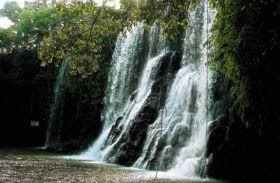 Waterfall in balneario Bahr, in the community of Yojoa, Honduras
Waterfall in balneario Bahr, in the community of Yojoa, Honduras
March 22, 2007 was World Water Day. And guess what? Sunday we had no water! How ironic. Or how prescient.
 Not having water at least part of the time is the norm in Honduras; having running water 24 hours a day is a luxury. Most times when we don't have water in our colonia (neighborhood), it is because the electricity goes out and once the neighborhood tank empties, there is no water until the electricity comes back on. Sometimes the pump breaks and parts have to be ordered from another city or country. Sometimes construction workers break a pipe and we have no water for a day or two until the pipe gets repaired. That is more frequent than you might imagine.
Not having water at least part of the time is the norm in Honduras; having running water 24 hours a day is a luxury. Most times when we don't have water in our colonia (neighborhood), it is because the electricity goes out and once the neighborhood tank empties, there is no water until the electricity comes back on. Sometimes the pump breaks and parts have to be ordered from another city or country. Sometimes construction workers break a pipe and we have no water for a day or two until the pipe gets repaired. That is more frequent than you might imagine.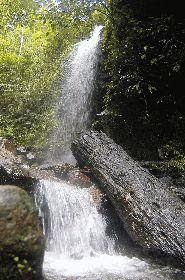 In much of Honduras, though, there is no running water. In some areas big water tanker trucks deliver water to people who bring their buckets to the truck to fill up. Some companies, such as some of the coffee companies, supply water for free as a community service.In other areas water is obtained daily from the nearest river, often by children who don't go to school as it is their responsibility to supply the daily water needs of the family. You can imagine how many trips it takes for young children who can only carry one or two gallon jugs of water at a time.In many communities where there is running water, it is often for only one or two hours a day and then it is turned off. During the dry season when the rivers dry up, it's not unusual for many areas to go a week or even longer without any water at all. And then when it is turned back on, people may have an hour or two to fill all their water containers before it will be turned off again.Some municipalidades (municipal governments) cycle the water between colonias because there isn't enough pressure to provide water to all at once. Interestingly, though, the wealthier neighborhoods rarely have this problem and almost always have water 24 hours per day. Sometimes during the rainy season, the water has to be turned off because of the amount of sediment in the rivers.
In much of Honduras, though, there is no running water. In some areas big water tanker trucks deliver water to people who bring their buckets to the truck to fill up. Some companies, such as some of the coffee companies, supply water for free as a community service.In other areas water is obtained daily from the nearest river, often by children who don't go to school as it is their responsibility to supply the daily water needs of the family. You can imagine how many trips it takes for young children who can only carry one or two gallon jugs of water at a time.In many communities where there is running water, it is often for only one or two hours a day and then it is turned off. During the dry season when the rivers dry up, it's not unusual for many areas to go a week or even longer without any water at all. And then when it is turned back on, people may have an hour or two to fill all their water containers before it will be turned off again.Some municipalidades (municipal governments) cycle the water between colonias because there isn't enough pressure to provide water to all at once. Interestingly, though, the wealthier neighborhoods rarely have this problem and almost always have water 24 hours per day. Sometimes during the rainy season, the water has to be turned off because of the amount of sediment in the rivers. The problem is getting worse all the time because of the continued deforestation of the mountains. The government has proclaimed a good part of the country's forests as protected areas and has strict laws about cutting trees, but for the most part, the laws are ignored and not enforced. We have seen big flat bed trucks full of huge freshly cut trees going down the highway on Saturday afternoons and Sundays when most of the government is shut down. As you can imagine, every household maintains their own supply of water in whatever types of sinks and buckets and containers they can scrounge up, most without lids. Those who can afford it have an underground cistern or above ground tinaco (fiberglass water tank). The most commonly used container is a pila (an outdoor concrete washtub).People have to maintain their own water to survive, but a side effect is that those containers can be a haven for mosquito larvae. Like most of Central America, Honduras has very high rates of malaria and dengue fever. I am very skeptical of any statistics because you have to consider that the majority of cases never get reported since many people can't afford go to a doctor, many others don't have access to a doctor, and there is no treatment for classic dengue anyway.
The problem is getting worse all the time because of the continued deforestation of the mountains. The government has proclaimed a good part of the country's forests as protected areas and has strict laws about cutting trees, but for the most part, the laws are ignored and not enforced. We have seen big flat bed trucks full of huge freshly cut trees going down the highway on Saturday afternoons and Sundays when most of the government is shut down. As you can imagine, every household maintains their own supply of water in whatever types of sinks and buckets and containers they can scrounge up, most without lids. Those who can afford it have an underground cistern or above ground tinaco (fiberglass water tank). The most commonly used container is a pila (an outdoor concrete washtub).People have to maintain their own water to survive, but a side effect is that those containers can be a haven for mosquito larvae. Like most of Central America, Honduras has very high rates of malaria and dengue fever. I am very skeptical of any statistics because you have to consider that the majority of cases never get reported since many people can't afford go to a doctor, many others don't have access to a doctor, and there is no treatment for classic dengue anyway. While there are many measures that can and should be taken to reduce the incidence of these diseases, the need to store water is not such an easy one to solve.Many other diseases are prevalent because of the contamination of the water. There is always more sickness, especially among children, during the rainy season. The newspaper reports seem to imply that the increased illness is a direct result of rain. Many people actually believe that rain makes them sick, not realizing that the ground contamination of the water is a more likely culprit.
While there are many measures that can and should be taken to reduce the incidence of these diseases, the need to store water is not such an easy one to solve.Many other diseases are prevalent because of the contamination of the water. There is always more sickness, especially among children, during the rainy season. The newspaper reports seem to imply that the increased illness is a direct result of rain. Many people actually believe that rain makes them sick, not realizing that the ground contamination of the water is a more likely culprit.
Rivers, streams, and the ocean are used as convenient trash receptacles throughout the country. Motor oil and every imaginable type of contaminant are poured into the sewer drains and on vacant properties to later drain into the rivers and ultimately the ocean. Open sewer lines are common and a big cause of water contamination.While some of the problems can be blamed on those who may not know any better, much of the water and land contamination is a result of the mostly foreign-owned maquillas (factories) who no doubt have to follow stricter practices in their own countries. The runoff of chemicals from maquillas and foreign-owned mines, and chemical fertilizers, insecticides, and herbicides from the agricultural fields are a serious problem in this country.It isn't only Honduran waters that are being damaged. According to the World Resources Institute:
"More than 80 percent of the sediment and 50 percent of the pollutants entering the coastal waters of the Mesoamerican Barrier Reef originate from human activities in nearby mountainous Honduras. The analysis is the first to determine the origin and volume of sediment and pollution that run off agricultural lands, via the region’s vast river networks, into the neighboring Gulf of Honduras and Caribbean Sea. The waters are home to the Mesoamerican Barrier Reef – the largest coral reef system in the Western Hemisphere, stretching for more than 600 miles, and shared by Belize, Guatemala, Honduras and Mexico."
Throughout this article are photos of some of the beautiful water sources in Honduras as shown in a recent La Prensa article. It's hard to imagine that a country with so much water has none for many of its people.
Rainy season or dry season, there is always a problem getting water in Honduras. The problems will only get worse if the government continues to allow the deforestation of the mountains and doesn't take sanctions against those who contaminate the water we have left.
 (No, ours isn't quite this old, but....)
(No, ours isn't quite this old, but....)


6-week-old Chihuahuas
El Jefe is taking the flyers below to the two veterinarians today and a couple of agropequarias (feed stores). I had these two individual photos on it. El Jefe made me take them off. I think he doesn't want to sell "Blackie."
Actually, we need at least a few more days to wean them. They are being stubborn about that, even though they have mouthfuls of tiny, sharp teeth that Zoe is not appreciating these days.
This is stressful! I want to keep them all, or at least Blackie and the runt of the litter. Will anyone take as good care or love them as much as we do?
______________________________________________
Se venden

Cachorro Chihuahuas
Tenemos cuatro machos puros, tendrán 6 semanas el 22 de Marzo. Tenemos la madre y padre.
Telefono: x-xxx-xxxx
 ______________________________________________
______________________________________________
 Ferocious even with its head cut off
Ferocious even with its head cut off Frank found and killed this snake in one of the jardineras (concrete planter boxes). It looked harmless to me, but no one asked me before they killed it.
Frank found and killed this snake in one of the jardineras (concrete planter boxes). It looked harmless to me, but no one asked me before they killed it.
Frank always likes to show me the scary things and then seems a little disappointed that I say, "Pobrecito" (poor little thing). He knows that I take pictures of weird things for the internet so he always brings them to me.This is terrible to say, but it stayed alive for quite some time after Frank cut it in half. While he was posing it with a stick for the photo, the snake opened his mouth to attack. The tail end keep slithering for almost an hour.The snake measured one meter (39 inches).May he rest in peace.
 Every good website has a FAQ (Frequently asked questions), right? So here we go.
Every good website has a FAQ (Frequently asked questions), right? So here we go.
How do I find stuff on your blog?
I'm embarrassed to tell you how long I read blogs before I noticed that Blogger search box in the upper left corner! It really works. If you are looking for something specific, like, say Dijon mustard, you can search this blog by using the search box. Dijon mustard gives five articles − I'm obsessed! I also have a Google blog search box in the sidebar.
Another way to find what you're looking for is with the list of topics (categories) in the sidebar. If you came to this blog to read about food, for example, click on the topic in the sidebar and you'll get all of the articles related to that topic together on one or more pages.
But I want to know something else!
If there is something particular you are interested in about La Ceiba, don't hesitate to ask. New ideas are always welcome. If I know something about it or can easily find out (I'm basically lazy, you know), I'll be happy to write about it. Don't try to give me a job though, because I'm not going to do it. ;-)
How can I remember to come back here?Well, you could bookmark it, but that is so 20th century.
Click 'Subscribe' beneath the blog title to see the options to subscribe to La Gringa's feed for your Yahoo, MSN, AOL, or Google homepage, Bloglines or just about any other newsreader. Go ahead − try it. It won't bite. You don't even have to know what a feed is.
Newsreaders are the way to go. It's really the only way to keep up if you like to read several blogs. I used to like the Bloglines newsreader. I'm now checking out Google Reader. I think I'm going to stick with Google Reader but they are both relatively easy to learn to use. And like all my recommendations, they are free.
But if all this is just too confusing, you can subscribe to have a daily email delivered to you.
Why don't you answer my comments?
I do! I do! You just forgot to come back to see. In the "Subscribe" section, you also can sign up to receive all the comments in your newsreader, too. That is so that if you leave a scintillating comment and want to see what I and everyone else has to say about it, you can get the feed instead of coming back to check the comments. You can also sign up to receive follow-up comments on a specific article by email, but only if you comment on the article.
Don't you like me? Why won't you give me a link?
I love so many blogs and consider bunches of you bloggers as real friends! But I made a decision a long time ago that I was going to highlight only Central American and Mexican blogs on my blogroll. The reason is that I feel they are largely ignored by the rest of the world and for the most part, are difficult to find. So I'm just trying to do my part for the under-appreciated.
What are "Shared Items?"
One of features that I like about Google Reader is "Shared Items." If I like an article on someone else's blog and I think that my internet readers, who obviously are extremely intelligent and have excellent taste in blogs, might enjoy it, too, I just click to add it to my shared items. If you look on the side bar on the right, down towards the bottom, you'll see "La Gringa's shared items." You can click on an individual article to go to that blog or you can click "read more" to see all my shared items. From my shared items page, you can click to go to any of the other blogs.
La Gringa's guest map
Look for the "Guest map" link at the top. Click to leave a message, mark your location, and upload a photo if you like. Feel free to look at the photos and comments left by other guests.
How much time do you spend on your blog?
Way too much!
Who are you? Are you a real person?
Yes, I am real. Yes, I live in La Ceiba, Honduras − you don't really think I could make this stuff up, do you? Come on! Besides, if I was fake, I wouldn't be constantly admitting all the stupid stuff I do, now would I?
What's your name? Why don't you use it?
Well, I've really never liked my name if you want to know the truth. When I would meet someone when I was a little girl, people would always say, "Oh, that's my grandmother's name!" No little girl wants to hear that. I always wanted a name like Suzi or Debbie, or at least a cute nickname like everyone else. Now I have one!
I write about my life here in Honduras and the things I see around me and in the newspapers. It's not always pretty. I've been griped at by real estate agents, tourism people, and others who don't want me to write the truth as I see it. One reader kept asking where my house is located. A couple of others said that I should get my @$# off the internet or out of Honduras. This is a dangerous country. For those reasons, I won't use my name in this blog. If you know my name, I hope you won't use it either.
How much does it cost to live in Honduras?
I answered this as best I could in Cost of living in La Ceiba. Prices of just about everything have risen tremendously since then, so I really need to do an update. Like anywhere else in the world, it depends upon where you live and how you live.
How much does a house cost in Honduras?
That is a really tough question to answer! I did the best I could in this article.
What is the crime situation really like in Honduras?
I know that you are asking me this because you want me to say it is no worse than some parts of the U.S. I really can't say that. The 2006 murder rate in Honduras was 46.2 per 100,000 population, with some states being as high as 71.7. That is compared to an average of 8.8 worldwide. The 2005 U.S. average was 5.6 per 100,000. Home burglaries and petty theft are rampant. Being a relatively well-off person in a poverty stricken country makes you a target in some respects and helps to insulate you from much of the crime in other respects. If you want to learn more, read the Honduran 2007 Crime and Safety Report.
What is the weather like in La Ceiba?
Hot and humid most of the time. I wrote more in How is the weather in La Ceiba. You can also click the "Weather" topic in the sidebar to read me complaining of it being too hot or too cold.
When is the rainy season in Honduras?
There is no one rainy season in Honduras. It varies depending upon the part of the country you are talking about. On the north coast, we get rain pretty much year round, just more of it during September through March. The article mentioned in the previous question gives more details and a link which explains even more.
Didn't you spell Blogicito wrong?
Yes, I did. Thank you for reminding me. I spelled it in Spanglish and admitted it in Title dilemma. By the way, if you don't know Spanish, anything that ends with a '-ito' means 'little whatever,' e.g., little blog.
More FAQs
You can read other frequently asked questions in the FAQs topic here. To see them all, click on "older posts" at the end of each page.
 Great Kiskadee, our early morning alarm clock
Great Kiskadee, our early morning alarm clock
Another thing is that I've been depressed. We've lost two of our chickens and another one seems that she won't recover enough to be able to survive on her own. Our neighbor's dog was poisoned yesterday and I'm worried sick someone will try to poison our dogs. Our house has things that still aren't finished or are broken and we have no idea where to find a decent workman to do them. I broke my brand new camera! And just in general, I'm feeling like a loser. How's that for pouring it all out?
Reader Ki gave me one idea − he suggested that I am possibly brain damaged from bashing my head into a 2x4 a few years ago. ;-) I kind of like that idea as a built-in excuse, but does anyone have other ideas or suggestions about getting yourself (myself) organized?
I'm going to post this now before I erase it and tell you what a perfect day I had today.
 They had it. They just couldn't sell it. One of the gas stations in town was closed today. The gas pump attendant who couldn't pump gas told El Jefe that the cashier didn't show up for work today. Can you imagine this? How much money did the gas station and convenience store lose today because it was closed? Will the other employees get paid even though they couldn't work? I think that if it was my gas station or if I was the manager, I would be running the cash register or pumping gas, or whatever it took to keep the business going on a busy Saturday. Saturday is payday in Honduras! I would have also cross-trained employees or had a backup cashier, because surely you can't close your business every time the cashier doesn't show up?Here in La Ceiba, managers usually don't step up to help out when things get busy. It's beneath their position in life. Bank lines can be 40 or 50 people deep, while managers and others sit around filing their fingernails or giggling on the telephone. It's often impossible to even talk to a manager. They are usually behind solid doors and dark glassed windows and rarely ever deign to speak to a customer. Four times out of five, if you ask to speak to a manager, you will be told that they are in San Pedro Sula. Ha ha. We've heard that more than a few times. Employees are afraid to bother their managers with a question.Owners are even a step above that. I'm not talking about the little mom and pop places. Of course that is different. Owners are rarely on site at larger restaurants or stores. They really should be. They might find out how rude their employees are to the customers or even that their employee is watching television with the doors locked to customers! I've seen this! And then eventually, I saw that that store closed down.Only in Honduras.
They had it. They just couldn't sell it. One of the gas stations in town was closed today. The gas pump attendant who couldn't pump gas told El Jefe that the cashier didn't show up for work today. Can you imagine this? How much money did the gas station and convenience store lose today because it was closed? Will the other employees get paid even though they couldn't work? I think that if it was my gas station or if I was the manager, I would be running the cash register or pumping gas, or whatever it took to keep the business going on a busy Saturday. Saturday is payday in Honduras! I would have also cross-trained employees or had a backup cashier, because surely you can't close your business every time the cashier doesn't show up?Here in La Ceiba, managers usually don't step up to help out when things get busy. It's beneath their position in life. Bank lines can be 40 or 50 people deep, while managers and others sit around filing their fingernails or giggling on the telephone. It's often impossible to even talk to a manager. They are usually behind solid doors and dark glassed windows and rarely ever deign to speak to a customer. Four times out of five, if you ask to speak to a manager, you will be told that they are in San Pedro Sula. Ha ha. We've heard that more than a few times. Employees are afraid to bother their managers with a question.Owners are even a step above that. I'm not talking about the little mom and pop places. Of course that is different. Owners are rarely on site at larger restaurants or stores. They really should be. They might find out how rude their employees are to the customers or even that their employee is watching television with the doors locked to customers! I've seen this! And then eventually, I saw that that store closed down.Only in Honduras.
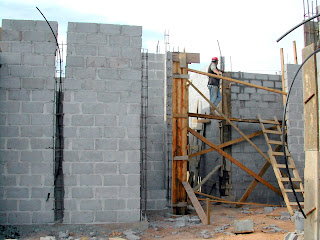 Homemade ladder and scaffolding
Homemade ladder and scaffolding
If you can open this photo and enlarge it (Google's free Picasa is excellent for that), you'll see the homemade ladder and the andamios in more detail. Braces of 2"x4"s are nailed to the window frames and/or nailed to a vertical board standing inside the house to support the tall vertical 2"x4"s outside the house − kind of like an 'H' with a short leg on one side. The horizontal 2"x10"s or even two 1"x10"s stacked together are what the workers walk on.
I'm not going to translate the measurements to centimeters because here in Honduras, although we use the metric system for most measurements, wood is measured in inches and feet. A 2x4" board would measure 5x10 cm. (As an aside, meat and vegetables are measured in pounds, not kilograms.)
The braces placed at an angle appear to be haphazard but these guys know what they are doing. Each albañil (mason) usually builds his own andamio − I would, too, wouldn't you?
The scaffolding had to be more or less rebuilt higher every 6 feet (2 m.) so the workers could reach where they needed to work. It was incredible to see how quickly the albañiles could build one of these scaffolds, tear it down and then build another one in another location.
The back of the house is much taller than the front due to the slope of the property and the fact that we have a second story on part of the house. This roof line is at least 20 feet high. The albañiles stood on that upper horizontal board to do the stucco work. They needed the boards elsewhere so afterward they tore it down and built another one. Later the sheet rock workers came along and built their own andamio to do the soffit under the roof.
I had occasion a few times to walk on some of these andamios (not this one!). The horizontal boards would bounce and sag with each step. I was scared to death.
If you can enlarge this photo, you'll see that two smaller ladders were nailed together in order to reach the taller part of the house. It seems to be the custom with each batch of wood to cut all the small pieces needed and then nail them back together when they needed long pieces.
The same happens with the ladders. The electricista (electrician) cut this ladder in half when he needed a short one and then the tabla yeso (sheet rock) guys nailed it back together when they needed a tall one.
Amazingly, no one got hurt anytime on our construction, except me. One day the front doorway was blocked with andamio braces so I climbed in a nearby window. I was paying so much attention to not stepping on nails or tearing my clothes on nails sticking out of boards (as I did so often) that I rammed my head right into the end of a 2"x4" board which was sticking out the side of the window.You know how when you bump your head and it hurts so much that you think it must be bleeding so you reach up to put your hand on it? Well, I did and my hand came back drenched with blood.
I sat down on the window sill a little stunned and called for El Jefe. He was busy upstairs passing out cokes and snacks to the workers and yelled, "Yeah, yeah, just a minute." I called again with more urgency. Meanwhile, blood was gushing all over the ground, dripping down my face onto my clothes. One of the workers rushed over. He took one look and yelled, "Get your #*& down here now, Jefe!" He gave me a dirty rag to put over the wound which I gladly used.El Jefe rushed me to Hospital D'Antoni where they stitched up my head, which later swelled up like a lopsided cantaloupe. I had a black eye and I looked so freaky with my melon-head that I didn't leave the house or answer the door for a week. Uh, I won't be showing pictures of that, even though El Jefe did feel compelled to take a photo of that grotesque sight!
Believe it or not, a situation arose in which El Jefe and I had to climb all over this steep roof and measure the whole darn thing. That's a whole 'nother story, but let me tell you, this roof is steep. The workers walked all over the roof like it was nothing. I mostly crawled hanging on to those boards like my life depended on it. I'm not good with heights at all. Everyone was incredulous that a woman would do that.
We also found that we can see the ocean from our roof. Too bad we didn't build a terrace up there like many folks do.
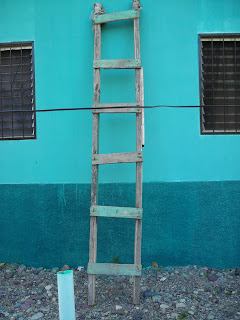 Maybe not.
Maybe not.
 Tostones
Tostones
oil for frying
salt to taste Heat oil in a heavy skillet or deep fryer to 375°F. Peel* plantains and cut into 1 inch slices.
Heat oil in a heavy skillet or deep fryer to 375°F. Peel* plantains and cut into 1 inch slices.
 Place a few plantain slices in the hot oil and cook until tender and golden in color, about 3-4 minutes. Drain on paper towels. Repeat with remaining slices.While the slices are still warm, smash them with your rock, a meat mallet, or a large flat bottomed cup until they are about 1/4 inch thick.
Place a few plantain slices in the hot oil and cook until tender and golden in color, about 3-4 minutes. Drain on paper towels. Repeat with remaining slices.While the slices are still warm, smash them with your rock, a meat mallet, or a large flat bottomed cup until they are about 1/4 inch thick.
 This photo shows the size of the smashed tostones compared to one unsmashed one on the left. The size of the tostones will depend upon the thickness of the plantains and the thickness of the slices.
This photo shows the size of the smashed tostones compared to one unsmashed one on the left. The size of the tostones will depend upon the thickness of the plantains and the thickness of the slices.
Return a few at a time to the hot oil, without overcrowding, and continue frying until crisp and deep golden, but not brown, about 3 more minutes. When they are perfectly done, they are crispy on the outside but still tender inside.
 Drain on paper towels and season lightly with salt. Serve as a snack or side dish Honduran style with mantequilla blanca (similar to crème fraîche or a thin sour cream), Puerto Rican style with mojo, or Panamanian style with ketchup. They can also be topped with cheese or various other toppings or dips as an appetizer.These tostones turned out yummy and this Popuolu has a good flavor. If you've never had plantains, you should know that they have no banana flavor. I don't much like bananas but I love plantains.
Drain on paper towels and season lightly with salt. Serve as a snack or side dish Honduran style with mantequilla blanca (similar to crème fraîche or a thin sour cream), Puerto Rican style with mojo, or Panamanian style with ketchup. They can also be topped with cheese or various other toppings or dips as an appetizer.These tostones turned out yummy and this Popuolu has a good flavor. If you've never had plantains, you should know that they have no banana flavor. I don't much like bananas but I love plantains.
Tostones are very filling. As an appetizer, one or two good sized tostones would be more than enough. As a side dish with a full meal, one-half plantain per person would probably be enough.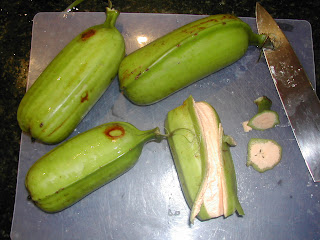 *Peeling green plantains: If you've never used unripe bananas or plantains before, you'll find that you can't peel them the way you can a ripe banana.
*Peeling green plantains: If you've never used unripe bananas or plantains before, you'll find that you can't peel them the way you can a ripe banana.
Green bananas or plantains are peeled by cutting off the small part of both ends, then using the tip of a knife to slit the peel lengthwise trying not to cut into the fruit.
 Use your fingers or a knife to try to loosen and pry the cut edge of the peel away from the fruit. Once you have loosened the edges of the cut, you should be able to pull off the peel in sections.
Use your fingers or a knife to try to loosen and pry the cut edge of the peel away from the fruit. Once you have loosened the edges of the cut, you should be able to pull off the peel in sections.
I'm usually pretty good at this but these were very thin-skinned plantains which had to be peeled with a knife. Generally the peel is much thicker.
 I mentioned in my earlier article today that some sources referred to these weird shaped 'bananas' as plantains. This picture shows that whether I have Popoulus or another variety, they are definitely plantains and not bananas.
I mentioned in my earlier article today that some sources referred to these weird shaped 'bananas' as plantains. This picture shows that whether I have Popoulus or another variety, they are definitely plantains and not bananas.
Plantains, or plátanos in Spanish, turn this bright yellow color when cooked. Bananas do not. Case closed!
It is a good thing that they were plátanos because tostones are supposed to be made with plátanos, not bananas. They may be made with bananas in some countries, but I think that would be highly frowned upon here in Honduras.
 Popoulu Banana
Popoulu Banana
We be bananas, which has a compilation of information from different sources, says that Popoulu is originally from Polynesia and is popular in Hawaii. They say that the banana has a salmon pink flesh with a slightly acidic apple-like flavor that can be cooked or eaten fresh when it is ripe. Ruthy recommended cooking the ripe ones with brown sugar and cinnamon.
Some sources refer to Popoulu as a plantain rather than a banana, but I'm not even going to get into that!
We bought several banana and plantain pups (baby plants that grow up around the mother plant) from a man who was growing them in his backyard. It's very strange that he didn't mention that these were an unusual variety.
I know that the platanos are plantains but now I'm wondering if all of our banana plants are Popoulus or if we have some 'normal' bananas.
So it turns out that Frank was right. This strange looking fruit apparently is a desirable banana. Frank also says that he can tell a banana plant from a platano (plantain), so I'm going to trust his judgment.
El Jefe wants me to make tostones. So I think I'll try them for lunch today. I'll report back.









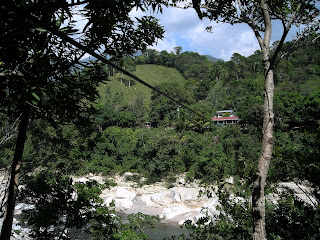



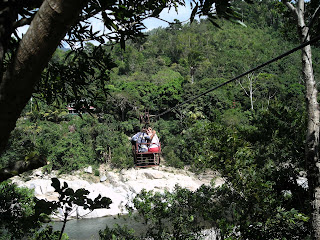





































 Welcome to my Blogicito —
Welcome to my Blogicito — 








